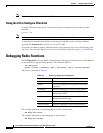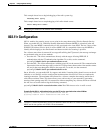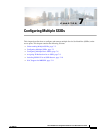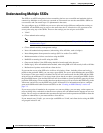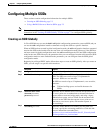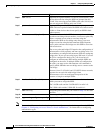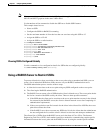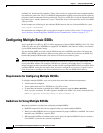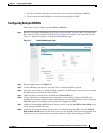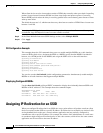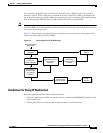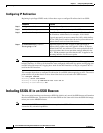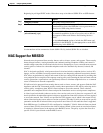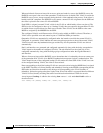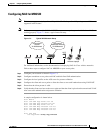
7-6
Cisco IOS Software Configuration Guide for Cisco Aironet Access Points
OL-30644-01
Chapter 7 Configuring Multiple SSIDs
Configuring Multiple Basic SSIDs
(attribute 26). Vendor-specific attributes (VSAs) allow vendors to support their own extended attributes
not suitable for general use. The Cisco RADIUS implementation supports one vendor-specific option by
using the format recommended in the specification. The Cisco vendor-ID is 9, and the supported option
has vendor-type 1, which is named cisco-avpair. The Radius server is allowed to have zero or more SSID
VSAs per client.
In this example, the following AV pair adds the SSID batman to the list of allowed SSIDs for a user:
cisco-avpair= ”ssid=batman”
For instructions on configuring the access point to recognize and use VSAs, see the “Configuring the
Access Point for Vendor-Proprietary RADIUS Server Communication” section on page 13-17”.
Configuring Multiple Basic SSIDs
Access point 802.11a, 802.11g, 802.11n radios support up to 16 basic SSIDs (BSSIDs). For 1130, 1240,
1300 series APs only up to 8 BSSIDs are supported. The BSSID is the radio mac address associated to
a given SSID (network name) string.
You use multiple SSIDs to assign a unique DTIM setting for each SSID to broadcast one beacon per
SSID. A large DTIM value increases battery life for power-save client devices that use an SSID, and
broadcasting multiple SSIDs makes your wireless LAN more accessible to guests.
Note Devices on your wireless LAN that are configured to associate to a specific access point based on the
access point MAC address (for example, client devices, repeaters, hot standby units, or workgroup
bridges) might lose their association when you add or delete a multiple BSSID. When you add or delete
a multiple BSSID, check the association status of devices configured to associate to a specific access
point. If necessary, reconfigure the disassociated device to use the new BSSID MAC address.
Requirements for Configuring Multiple BSSIDs
To configure multiple BSSIDs, your access points must meet these minimum requirements:
• VLANs must be configured
• Access points must run Cisco IOS Release 12.3(4)JA or later
• To determine the number of multiple basic SSIDs supported, enter the show controllers
radio_interface command. The radio supports multiple basic SSIDs if the results include this line:
Number of supported simultaneous BSSID on radio_interface: 16
Guidelines for Using Multiple BSSIDs
Keep these guidelines in mind when configuring multiple BSSIDs:
• RADIUS-assigned VLANs are not supported when you enable multiple BSSIDs.
• When you enable BSSIDs, the access point automatically maps a BSSID to each SSID. You cannot
manually map a BSSID to a specific SSID.
• When multiple BSSIDs are enabled on the access point, the optional SSIDL IE does not contain a
list of SSIDs; it contains only extended capabilities.



